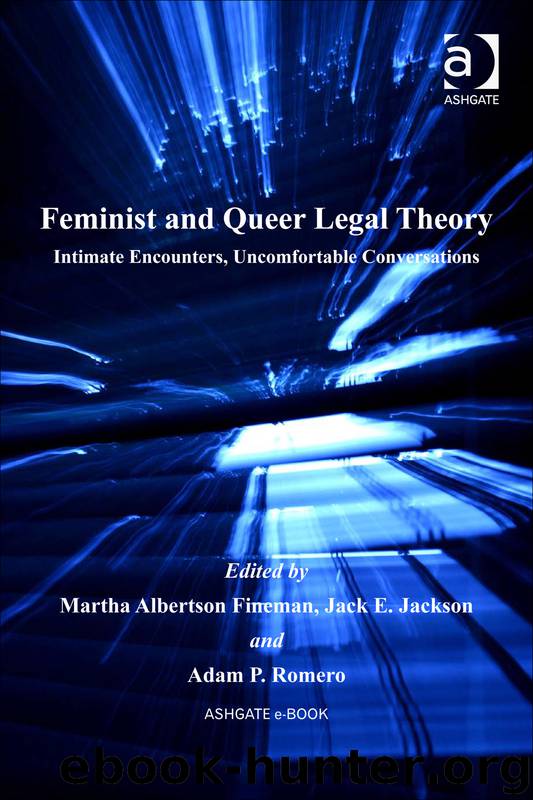Feminist and Queer Legal Theory by Martha Albertson Fineman & Jack E. Jackson & Adam P. Romero

Author:Martha Albertson Fineman & Jack E. Jackson & Adam P. Romero
Language: eng
Format: epub
Publisher: Ashgate Publishing Limited
Published: 2009-10-16T04:00:00+00:00
III. Representations and Representational Politics
Thus far, I have argued that gay activists’ employment of race/sexual orientation analogies deracialized aspects of sexual identity and desexualized aspects of racial identity. Black identity was essentialized as heterosexual and gay identity was essentialized as white. Racializing gay identity and sexuating black identity would have compelled the gay rights advocates to recognize not only black community identity differences (for example, the differences between heterosexual blacks and lesbian and gay blacks) but also gay community identity differences (for example, the differences between gay and lesbian blacks and gay and lesbian whites). This, in turn, would have required them to address the extent to which their own civil rights advocacy reflected racial hierarchy that privileged the identity position or victim status of white gay men and, to a lesser extent, white lesbians.
The racial hierarchy that gay rights advocacy produced was not just discursive, it was material as well. Gay rights activists selected specific individuals to function as representatives for gay and lesbian victimization. The experiences of these individuals—and their complete identities—were deployed to give content to, or put a face on, the social, economic, and psychological costs of military discrimination for lesbian and gay people. The hope was that this strategy would convey that real people—innocent, decent, hardworking people—people who were “just like everybody else,” were being harmed by military homophobia.
The real people gay rights proponents used to advance this story were themselves overwhelmingly white. More than that, they were “but for” gay people—people who, but for their sexual orientation, were perfectly mainstream. These icons of gay victimization were represented, in fact marketed, as “All American Kids”—the children next door. The images of gay identity that the activists presented to the American public were respectable and white.
Download
This site does not store any files on its server. We only index and link to content provided by other sites. Please contact the content providers to delete copyright contents if any and email us, we'll remove relevant links or contents immediately.
| African-American Studies | Asian American Studies |
| Disabled | Ethnic Studies |
| Hispanic American Studies | LGBT |
| Minority Studies | Native American Studies |
Cecilia; Or, Memoirs of an Heiress — Volume 1 by Fanny Burney(31324)
Cecilia; Or, Memoirs of an Heiress — Volume 3 by Fanny Burney(30928)
Cecilia; Or, Memoirs of an Heiress — Volume 2 by Fanny Burney(30885)
The Great Music City by Andrea Baker(21195)
We're Going to Need More Wine by Gabrielle Union(18065)
Bombshells: Glamour Girls of a Lifetime by Sullivan Steve(13101)
Pimp by Iceberg Slim(12923)
All the Missing Girls by Megan Miranda(12739)
Fifty Shades Freed by E L James(12443)
Norse Mythology by Gaiman Neil(11874)
Talking to Strangers by Malcolm Gladwell(11861)
Crazy Rich Asians by Kevin Kwan(8341)
Mindhunter: Inside the FBI's Elite Serial Crime Unit by John E. Douglas & Mark Olshaker(7827)
The Lost Art of Listening by Michael P. Nichols(6462)
Enlightenment Now: The Case for Reason, Science, Humanism, and Progress by Steven Pinker(6403)
Bad Blood by John Carreyrou(5761)
The Four Agreements by Don Miguel Ruiz(5502)
Weapons of Math Destruction by Cathy O'Neil(5029)
We Need to Talk by Celeste Headlee(4861)
